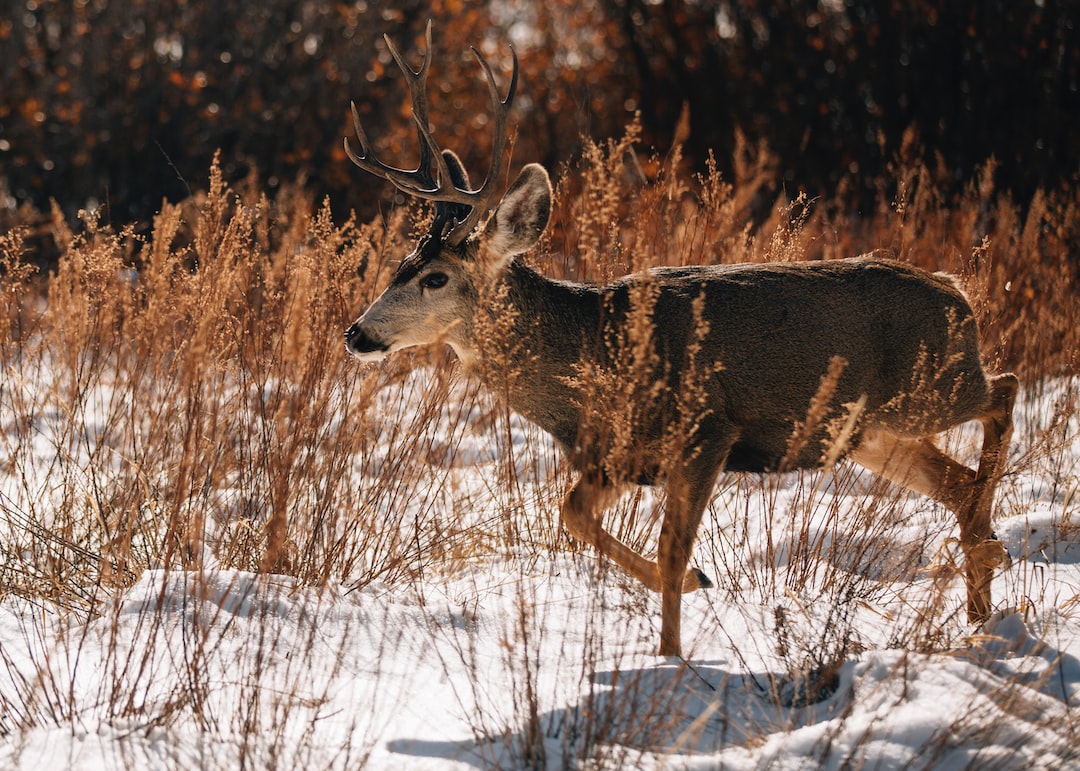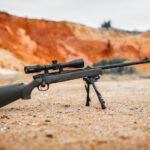Have you ever wondered what do deer tracks look like?
If so, then you’ve come to the right place.
Knowing how to recognize different types of deer and where they are found can help you understand which type of track is in front of your eyes.
Additionally, learning tips for tracking animals and understanding differences between elk and deer tracks will give you a leg up when it comes to hunting knowledge. Finally, we’ll discuss why knowing what the hooves are made out of can be useful in determining if those prints were left by a deer or not – plus more.
So let’s dive into all things related to doe (and buck) prints: What do they look like? How size relates to animal size? And how fresh are they anyway?
Is it a buck or a doe track? See for yourself:
Types of Deer and Where They Are Found
White-Tailed Deer:
White-tailed deer are the most common species of deer in North America. They inhabit a wide range of habitats, from dense forests to open fields and meadows. These animals have reddish-brown coats with white underbellies and distinctive white tails that they raise when alarmed. The males also grow antlers each year which can reach up to three feet in length.
Mule Deer:
Mule deer are found throughout western North America, from Canada down into Mexico. They have grayish brown coats with lighter undersides and large ears that give them their name – mule means “big ears” in Spanish.
Males grow impressive antlers that branch off into two points on either side of their heads, making them easily distinguishable from other species of deer.
Learn the difference between typical and non-typical deer.
Red Deer:
Red deer are native to Europe but were introduced to parts of North America by European settlers centuries ago. These animals have reddish-brown coats with light tan bellies and darker legs and necks than other species of deer. Male red deer also possess impressive antlers that can reach up to five feet long.
Deer species can be found in many parts of the world, with some preferring different climates and habitats than others. Knowing which type of deer is present in an area is important for understanding their behavior and tracking patterns – so let’s take a closer look at what deer tracks look like.
What Do Deer Tracks Look Like?
Deer tracks can be identified by their size and shape. The typical deer track is round or oval-shaped, with a slightly pointed toe.
White-tailed deer tracks are usually 2 to 3 inches in length, while mule deer tracks tend to be larger, up to 4 inches long. Red deer have the largest hooves of all species, measuring up to 5 inches across.
Identifying features in the track can help distinguish it from other animals’ prints. Deer typically leave two parallel lines of impressions when they walk due to their cloven hooves; this is known as “trampling” and is unique among ungulates (hoofed mammals). Additionally, if you look closely at a deer track you may notice that there are three distinct lobes on either side of the center line—these are called “crescents” and are also characteristic of deer prints.
By paying attention to these details, you should be able to accurately identify which type of animal left its mark. White-tailed deer often have longer toes than mule or red deer; mule deers’ toes tend to point outward more than those of other species; and red deers’ hooves often appear more squared off due to their larger size.
By understanding the size, shape and identifying features of deer tracks, you can become an expert in animal tracking. With these tips for tracking animals, you’ll be able to locate their trails and follow them with confidence.
Tips for Tracking Deer
Tracking deer is an important skill for any hunter or outdoors enthusiast. Knowing how to read the signs of wildlife can help you find your prey and understand their behavior. Here are some tips on tracking animals that will help you be successful in the field.
How to Tell How Fresh the Tracks Are:
The age of a track can tell you a lot about what animal made it and when they were there. Fresh tracks will have sharp edges, while older ones may have blurred or smudged outlines from weathering or other disturbances.
You should also look for signs of activity like scat, fur, feathers, or broken twigs that could indicate recent movement in the area.
Factors That Affect Track Visibility:
There are several factors that can affect how visible animal tracks are in different environments such as terrain type, soil composition, moisture levels, and vegetation cover. If you’re trying to identify tracks in soft ground like mud or sand then they’ll be easier to spot than if they were on hard surfaces like rock or concrete where they might not show up at all.
Additionally, heavy rainfalls can wash away existing prints making them harder to see even if they’re fresh.
Tracking animals is a skill that takes time and practice to master. With the right knowledge, strategies, and tools you can increase your chances of success in finding animal trails. Next we’ll explore what deer hooves are made of so you can better understand their tracks.
What Are Deer Hooves Made Of?
Deer hooves are the hard, keratin-based structures that grow from the bottom of a deer’s legs. They provide support and stability while allowing for mobility in various terrain.
The anatomy of a hoof consists of several parts including the outer wall, sole, frog, and heel bulbs. The outer wall is made up of tough layers of keratinized cells that form an armor-like shell around the sensitive inner tissues. It also provides traction when running or climbing on slippery surfaces like mud or snow.
The sole is located beneath the outer wall and acts as cushioning to protect against shock when walking over rough terrain such as rocks or roots. The frog is a triangular shaped pad located at the center of the foot which helps with balance and absorbs impact during movement.
Lastly, two bulbous protrusions known as heel bulbs can be found near each side of the frog providing additional cushioning for comfort while walking long distances over uneven ground.
There are three main types of hooves:
Cloven (split), single (monodactyl) and polydactyl (multiple toes). Cloven hooves have two distinct halves connected by a central cleft; this type is most commonly seen in species such as cattle, sheep, goats and deer.
Single hooved animals have one toe per foot; examples include horses and zebras who use their large single toe to gallop quickly across open fields with minimal effort expended on gripping onto soft soil surfaces like sand or grassy meadows Polydactyl feet contain multiple toes arranged in rows along either side giving them extra grip when traversing steep inclines or rocky outcrops where it may be difficult to maintain balance without slipping off ledges or sliding down slopes due to loose gravel underfoot .
FAQs in Relation to What Do Deer Tracks Look Like
How do you identify deer tracks?
To identify deer tracks, you must first look for the size and shape of the hoof print. Deer have two toes that form a heart-shaped pattern with a small notch in the middle. The front feet are larger than the back feet and have longer claws.
Look for signs of dewclaws, which can be seen as an extra set of marks on either side of the main track.
Additionally, examine any nearby vegetation to see if it has been disturbed or broken by passing deer. Finally, consider other environmental factors such as mud depth or terrain type that could help you determine whether or not these prints belong to a deer.
With practice and observation, you will soon become adept at recognizing deer tracks.
What would deer tracks look like in the snow?
Deer tracks in the snow can vary depending on the type of deer, terrain, and amount of snow. Generally, they appear as two oval-shaped indentations with a small triangular point at the front. The back of each track is usually more rounded than the front due to how their hooves are shaped. In deep snow, you may see only one large indentation from where both feet have sunk into it.
Deer also tend to walk in single file lines or paths which can be seen by looking for multiple tracks that all go in the same direction. When tracking deer through fresh snowfall, look for these signs and use them to help identify your quarry’s movements.
What do deer tracks look like in grass?
Deer tracks in grass can vary depending on the terrain and type of grass. Generally, they will appear as two oval-shaped depressions with a line connecting them. The front hooves tend to be slightly larger than the back ones, and the toes may have small indentations or grooves.
In soft soil, you may also see faint impressions from their dewclaws (small claws located behind each hoof). If there is snow or mud present, you may also notice furrows created by their hooves as they walk. Deer tracks are usually about 2-3 inches long and 1-2 inches wide.
Pay attention to any nearby trees or shrubs that could indicate a deer’s path of travel when looking for signs of deer activity in your area like a rub from a deer trying to lose its velvet.
What does a buck deer tracks look like?
Buck deer tracks can vary in size and shape depending on the terrain, but typically they are round or oval-shaped with two lobes at the front of the track. The rear part of the track is usually narrower than the front. On soft ground, you may be able to see distinct toes and claw marks as well as a heel pad that looks like an upside down heart.
In mud or snow, you may also be able to see drag marks from their tail or belly fur. Buck deer tracks are generally larger than doe deer tracks and can range anywhere from 2-4 inches long.
Conclusion
In conclusion, it is important to understand the different types of deer and where they are found in order to know what kind of tracks you may be looking at.
Knowing what do deer tracks look like can help you identify them when tracking animals in the wild. It is also important to remember that deer hooves are made of a hard material which makes them more visible than other animal prints.
With these tips for tracking animals, you will be able to determine how fresh the tracks are and how size relates to size of animal with ease. So if you ever find yourself wondering if you are looking at a set of deer tracks, now you have all the information needed to answer that question. Happy tracking!



